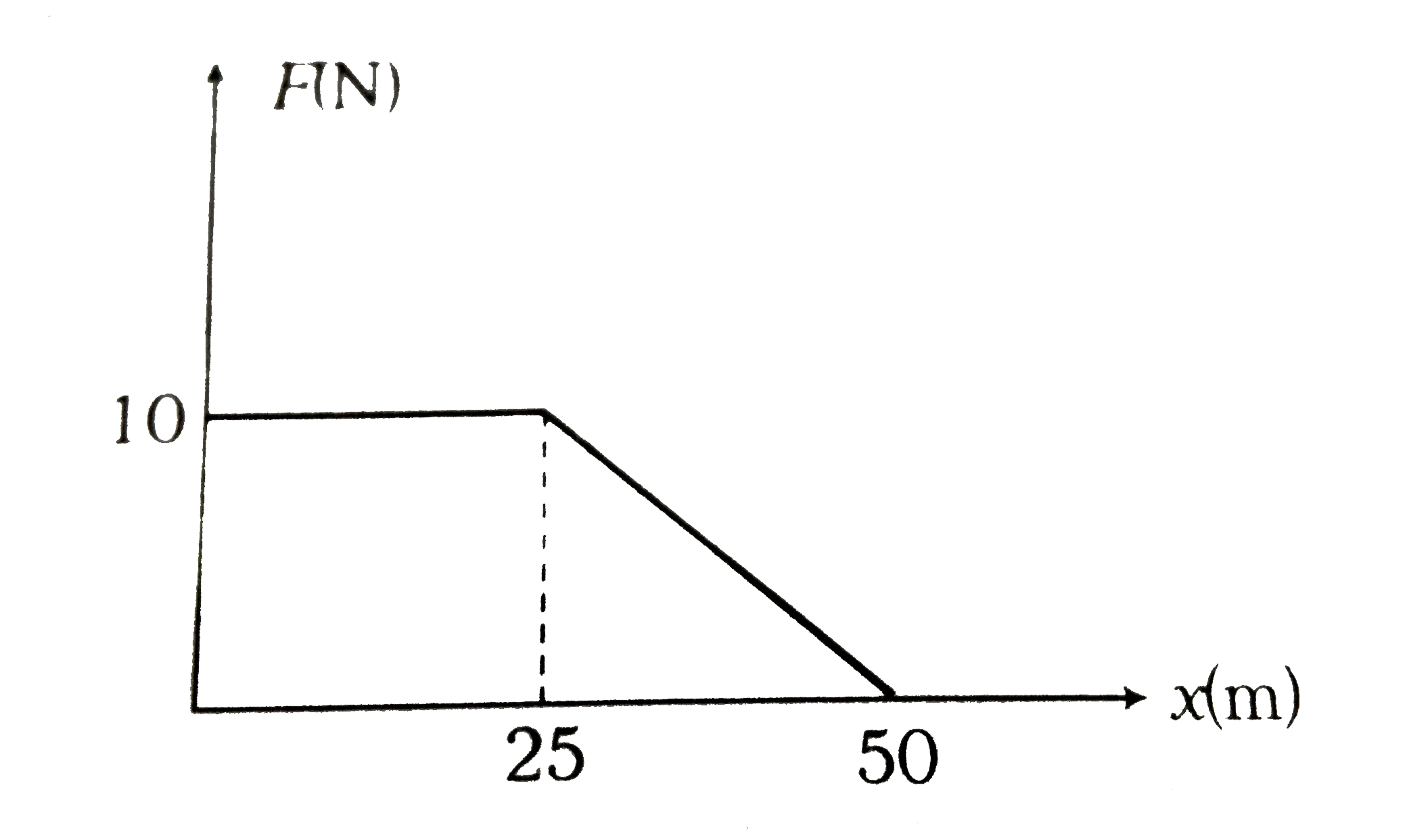A force on an object of mass 100 g is . The position of that object at t=2s is after starting from rest. The value of will be _________
The correct Answer is:2
To solve the problem, we need to find the ratio ab where the position of an object at time t=2 seconds is given as (a^i+b^j) meters. The object has a mass of 100 g and is subjected to a force of (10^i+5^j) N.
1. Convert Mass to Kilograms:
The mass of the object is given as 100 g. We convert this to kilograms:
m=100g1000=0.1kg
2. Calculate Acceleration:
Using Newton's second law, F=ma, we can find the acceleration a:
a=Fm=(10^i+5^j)N0.1kg=(100^i+50^j)m/s2
3. Use the Equation of Motion:
The object starts from rest, so the initial velocity u=0. The position s at time t can be calculated using the second equation of motion:
s=ut+12at2
Substituting u=0, a=(100^i+50^j)m/s2, and t=2s:
s=0+12(100^i+50^j)(22)
s=12(100^i+50^j)(4)=(200^i+100^j)m
4. Identify Values of a and b:
From the position vector s=(200^i+100^j)m, we can identify:
a=200,b=100
5. Calculate the Ratio ab:
Now, we can find the ratio ab:
ab=200100=2
Final Answer:
The value of ab is 2.
The mass of the object is given as 100 g. We convert this to kilograms:
m=100g1000=0.1kg
Using Newton's second law, F=ma, we can find the acceleration a:
a=Fm=(10^i+5^j)N0.1kg=(100^i+50^j)m/s2
The object starts from rest, so the initial velocity u=0. The position s at time t can be calculated using the second equation of motion:
s=ut+12at2
Substituting u=0, a=(100^i+50^j)m/s2, and t=2s:
s=0+12(100^i+50^j)(22)
s=12(100^i+50^j)(4)=(200^i+100^j)m
From the position vector s=(200^i+100^j)m, we can identify:
a=200,b=100
Now, we can find the ratio ab:
ab=200100=2
The value of ab is 2.
Topper's Solved these Questions
- BOOK - JEE MAINS PREVIOUS YEARCHAPTER - JEE MAINS 2022EXERCISE - PART : PHYSICS30videos
JEE MAINS 2022
- BOOK - JEE MAINS PREVIOUS YEARCHAPTER - JEE MAINS 2022EXERCISE - PHYSICS (SECTION -A)20videos
JEE MAINS 2022
- BOOK - JEE MAINS PREVIOUS YEARCHAPTER - JEE MAINS 2022EXERCISE - Physics-Section B10videos
JEE MAINS 2022
- BOOK - JEE MAINS PREVIOUS YEARCHAPTER - JEE MAINS 2021EXERCISE - Physics (Section B )10videos
JEE MAINS 2021
- BOOK - JEE MAINS PREVIOUS YEARCHAPTER - JEE MAINS 2023 JAN ACTUAL PAPEREXERCISE - Question360videos
JEE MAINS 2023 JAN ACTUAL PAPER
Similar Questions
Knowledge Check
- Question 1 - Select One
The force on a body of mass 1 kg is (20ˆi+10ˆj) N. If is starts from rest, then the position of the body at time t = 2 s, is
A−20ˆi−40ˆjB20ˆi−40ˆjC40ˆi−20ˆjD40ˆi+20ˆj - Question 2 - Select One
An object of mass 5 kg is acted upon by a force that varies with position of the object as shown. If the object starts out from rest at a point x=0. What is its speed at x=50 m.
 A12.2ms−1B18.2ms−1C16.4ms−1D20.4ms−1
A12.2ms−1B18.2ms−1C16.4ms−1D20.4ms−1 - Question 3 - Select One
The work done by the forces →F=2ˆi−ˆj−ˆk in moving an object along the vectors 3ˆi+2ˆj−5ˆk is:
A−9 unitsB15 unitsC9 unitsDNone of these
A force (3ˆi+2ˆj) N displaces an object through a distance (2ˆi−3ˆj) m. The work done is :
View SolutionA massless spring hangs from the ceiling with a small object attached to its lower end. The object is initially held at rest in a position y such that the spring is at its rest length. The object is then released from y and oscillates up and down, with its lowest position being 10cm below y, (a) What is the frequency of the oscillation? (b) What is the speed of the object when it is 8.0 cm below the initial position? (c ) An object of mass 600g is attached to the first object, after which the system oscillates with half the original frequency. What is the mass of the first object? (d) How far below y, is the new equilibrium (rest) position with both objects attached to the spring?
View SolutionA uniform force of (5ˆi+5ˆj)N acts on particle of mass 1 kg. The particle moves from r1=(3ˆi+4ˆj)m to r2=(5ˆi+8ˆj)m under this force. The work done by this force is
View SolutionAn object of mass 2 kg at rest at origin starts moving under the action of a force
→F=(3t2ˆi+4tˆj)N The velocity of the object at t = 2 s will be -View SolutionAn object of mass 3 kg is at rest. Now a force F=6t2ˆj+2tˆj N is applied on the object. Find the velocity of the object at t=3 sec.
View Solution

